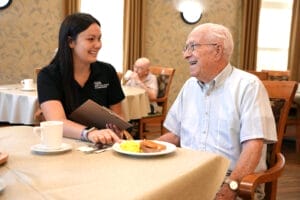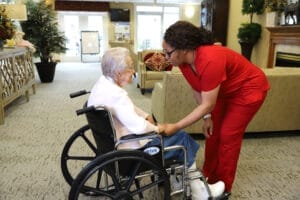Falls can be especially dangerous for seniors, because a senior is more likely to break a bone in a fall. A broken bone can lead to a long recovery period, as well as a loss of independence. According to the Centers for Disease Control, more than 90 percent of hip fractures among seniors are caused by falling.
When a senior has been injured in a fall, physical therapy and occupational therapy will be needed to improve mobility and make daily tasks easier.
Senior Fall Recovery
Senior rehabilitation after a fall usually includes a hospital stay, typically lasting from one to four days. Both physical and occupational therapy will begin working with recovering seniors while they are still in the hospital. Before the senior is released, the medical staff will want to make sure he or she is able to get up out of bed independently, be in control of their pain, is able to walk with an assistive device, and can manage daily tasks like eating and using the restroom.
If the senior isn’t able to accomplish these tasks independently, a stay in a rehabilitation or skilled nursing facility will be necessary. The senior rehabilitation process will include physical therapy to ensure that the senior is increasing flexibility, strength, balance and coordination. Being well physically is vital to preventing future falls. The physical therapist will provide muscle re-education as well as balance training and strengthening exercises, as well as gait training so the senior can learn how to walk with a cane or walker.
The physical therapist will also recommend some exercises to continue doing at home once the senior is discharged. An assessment of why the fall happened in the first place will need to be done for proper senior fall recovery. For instance, did something in the environment cause the fall, like furniture or a rug being in the way, or was it because the senior was in poor overall physical health? Does the senior have good vision and hearing? The physical therapist will prescribe the correct physical therapy for seniors of all abilities depending on their needs, including training for walking correctly with a mobility aid like a walker or cane.
Also during the stay in the rehabilitation or skilled nursing facility, an occupational therapist will help ensure the senior is comfortable maintaining activities of daily living, like dressing, eating, bathing, grooming, etc. The occupational therapist will also perform a home safety test, in which they evaluate the senior’s living space and make suggestions for making the areas safe for daily living. This may include recommending the removal of throw rugs and some furniture which can be tripping hazards, as well as installing better lighting, grab bars and railings through the home.
Senior rehabilitation after a fall is important to ensure the patient has a full range of motion, less pain and is able to live as independently as possible.
For more information about Moving Forward Rehabilitation at American Senior Communities, please visit https://www.asccare.com/mf/.



